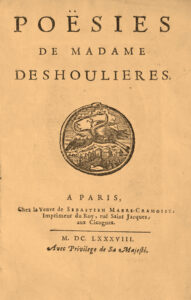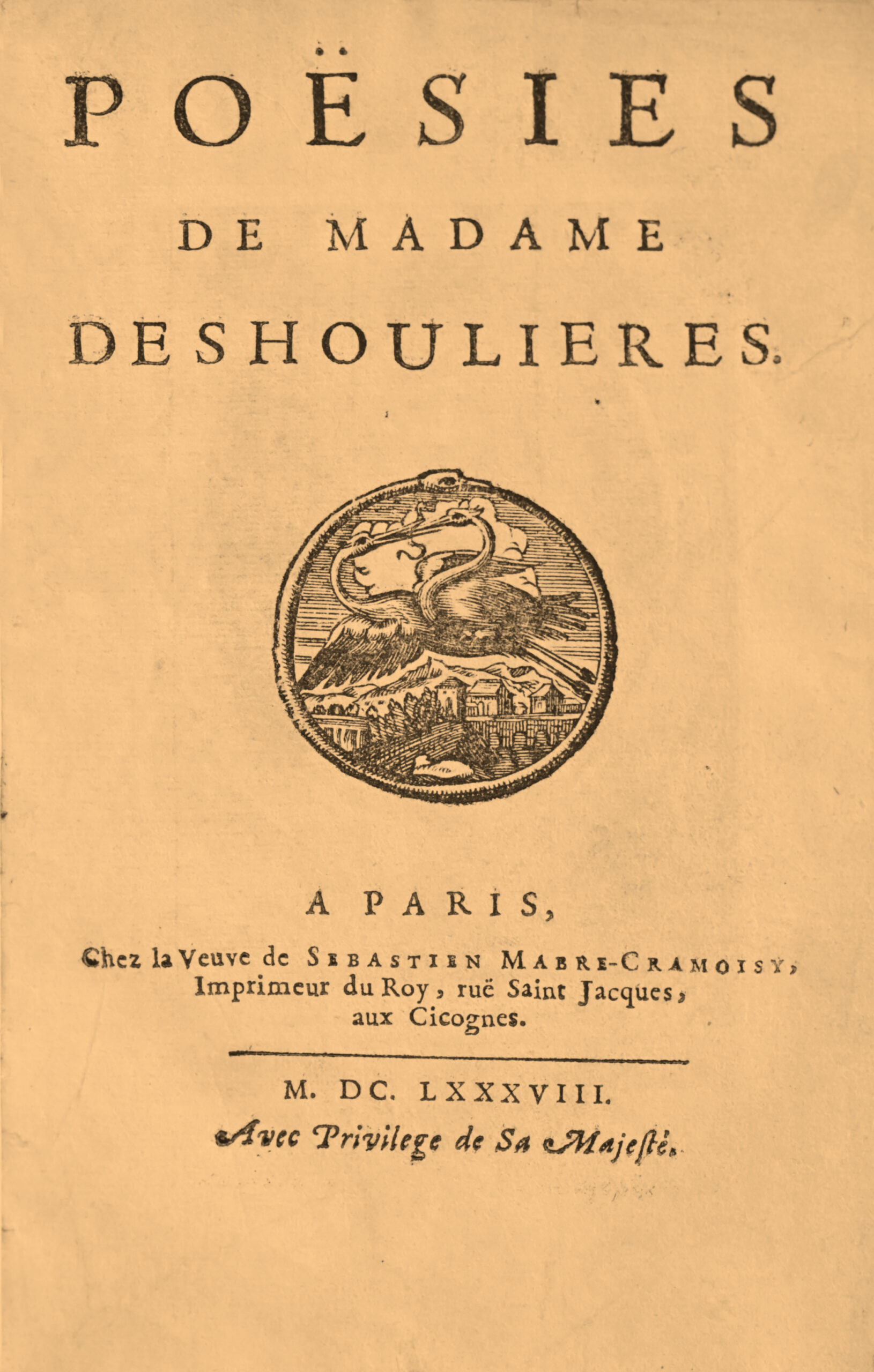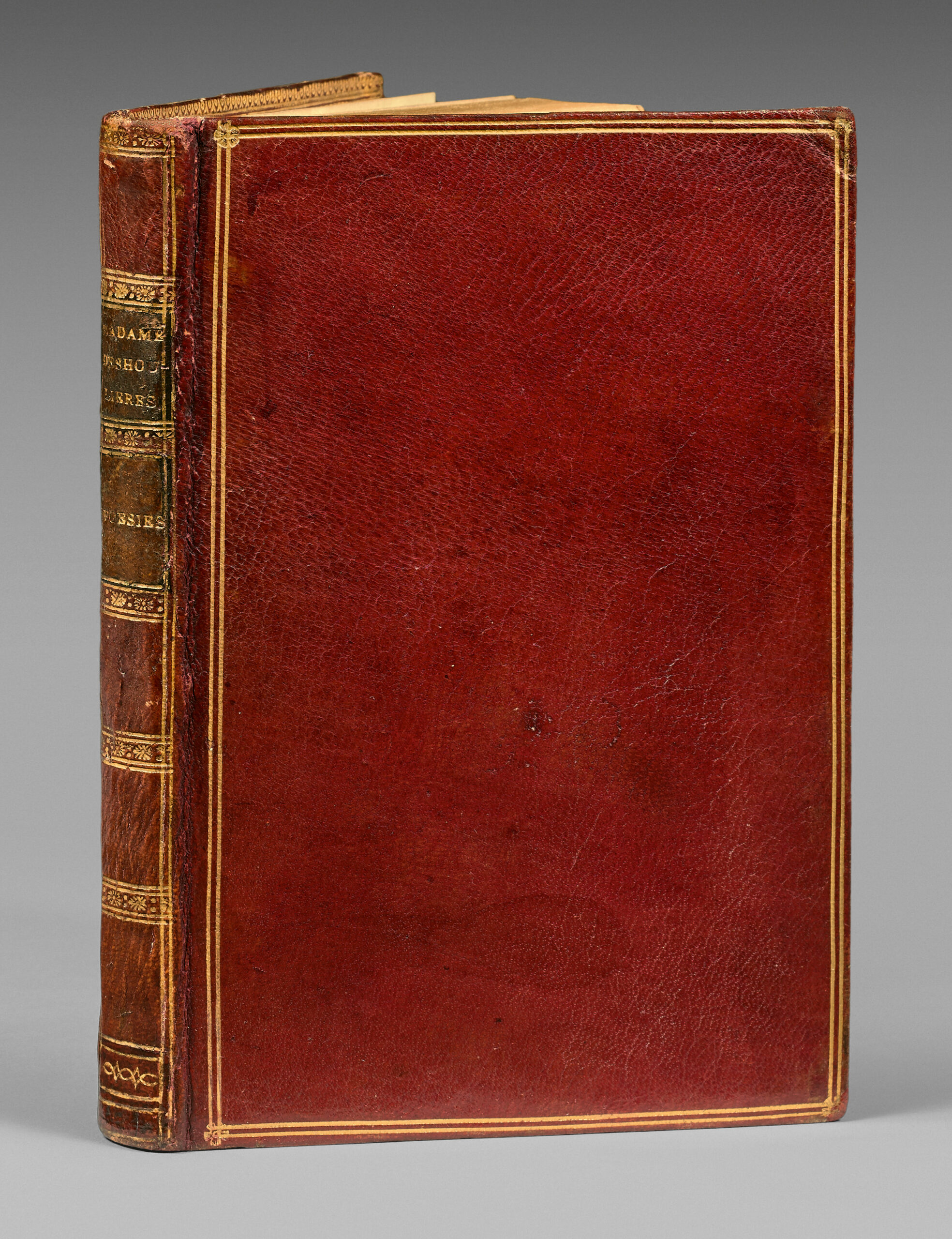In Paris, at the Widow of Sébastien Mabre-Cramoisy, 1688. With the Privilege of His Majesty.
Octavo (2) leaves, including the portrait of the author, 220 pages and (6) leaves for the Table, the Privilege of June 19, 1678, and the printing completed on December 30, 1687.
Full red morocco, double gilt fillet around the panels, smooth spine decorated, gilt fillet on edges, inner gilt roll, gilt edges. Binding by Pierre Anguerrand around 1730.
165 x 105 mm.
First edition of extreme rarity, published by the author, bound in old morocco, of the poems of Madame Deshoulières, one of the famous ‘Précieuses’.
Gifted with all the qualities of body and mind, she received the most refined education, learned Latin, Spanish, Italian, music, dance, and horse riding. She studied poetry under the guidance of a master, Hesroult. At thirteen, according to Sainte-Beuve, or eighteen according to other historians, she married Guillaume Deshoulières, an ordinary gentleman of Condé, whom she followed during the Fronde, going into exile with him in Brussels. Remaining in Paris, Madame Deshoulières associated with scholars and intellectuals: Ménage, Conrart, Benserade, and listened to Gassendi, adopting some of his theories (Bayle cited her in his article on Spinoza). Joining her husband in Brussels in 1655, she experienced worldly success, then was imprisoned for demanding too vehemently from the Flemish authorities the pension owed to her husband. Freed and returned to Paris, she befriended the best writers and the greatest names of society: Corneille, to whom she was always loyal, his brother Thomas, Pellisson, Quinault, Fléchier, Mascaron, La Rochefoucauld, Montausier, Vivonne, Saint-Aignan, Vauban. She was particularly well received at the Hôtel de Bouillon and the Hôtel de Nevers. From there, she instigated and led the cabal against Phèdre by Racine. She hosted a literary salon and remained faithful to the admirations of her youth.
During the quarrel of the Ancients and the Moderns, she naturally sided with Perrault. Somaize included her in his Dictionary of the Précieuses, under the name Dioclée.
She specialized in pastoral poetry and managed to compose idylls or eclogues about the small or significant events of court life, such as ‘idylls’ on the death of Montausier, the king’s return to health, the birth of ‘Monsieur, duc de Bourgogne’, an eclogue entitled ‘Louis’. In her eclogues, elegies, epistles, and songs, she sings about her pets, her dog, her cat, her sheep, and her ewes.
The famous eclogue is still cited in anthologies: ‘On the flowering banks, Watered by the Seine…‘. She had grace, wit, softness, a rather lively sensitivity, and a certain naivety. Voltaire greatly admired her.
‘She long enjoyed the first place among women poets‘, wrote Sainte-Beuve.
The works of Madame Deshoulières often echo the intellectual games of her salon, a Parisian counterpart of the court of the young Louis XIV, frequented by the two Corneilles, Tallemant, La Rochefoucault, the duc de Montausier, Bussy-Rabutin… and Perrault.
‘But it is the elegiac and pastoral vein inherited from the Astrée that will make her fortune in the 18the century: her eclogues and idylls consecrate a serious poetry that advocates the innocent and bucolic life of animals, far from the passions of men corrupted by ambition and greed‘.This original edition of the Poems by one of our famous précieuses is very rare and has always been sought after by bibliophiles, notably the only two known copies in old morocco: the copy in old morocco with Madame de Chamillart’s arms , 1620 F. Or (a colossal bid) at the Baron Pichon sale and the second copy bound in old morocco – the present copy – around 1730 by Anguerrand from the library of the, 1620 F. Or (enchère colossale) à la vente du Baron Pichon et le second exemplaire relié en maroquin ancien – le présent exemplaire – vers 1730 par Anguerrand provenant de la bibliothèque du duc de La Vallière.



